Explore Northern Italy in One Week
Artsy Traveler contains affiliate links for products and services I personally use and can happily recommend. As an Amazon Associate, I earn from qualifying purchases. Please read the Disclosure for more information. If you make a purchase through these links, at no additional cost to you, Artsy Traveler earns a small commission. Thank you!
This one-week itinerary for touring Nothern Italy provides a taste of stately Turin and sophisticated Milan, along with the deliciously jagged Dolomite mountains and the Italian Lakes.
Although my itinerary covers the high points, consider spending more time at the lakes (Maggiore, Orta, Como, Iseo, and Garda) or hiking in the Dolomites.
The views are stunning and the livin’ easy.
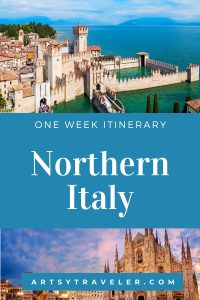
Why Tour Northern Italy?
This area of Italy is sometimes skipped in favor of Tuscany, Umbria, Rome and south to the Campania and Sicily. But I loved touring Northern Italy because it’s like a different country compared to other regions of Italy.
It’s still Italian with great food and plenty of amazing cultural sights, but it also feels much more Germanic as a result of its proximity to Austria, Switzerland, and Germany. I found the people more reserved than their southern neighbors, albeit still helpful and friendly.
Interesting Cities
The two main cities in Northern Italy are Turin and Milan. There are also some wonderful places to explore in the Veneto, such as Padua and Vicenza, but in this post, I’m focusing only on the area from Turin in the far west near the border with France to Bolzano near the border with Austria in the north.
Turin and Milan are both worth a few days of your time.

Stunning Landscapes
The other reason for spending time in Northern Italy is to explore the spectacular landscapes of the Italian Lakes and the Dolomites.
Getting Around Northern Italy
Taking Trains and Tours
You can travel easily by train between Turin and Milan and then take day tours to explore the Italian lakes and some nearby cities. See the section on the Italian Lakes below for suggested day tours of the lakes that depart from Milan.
Driving in Northern Italy
If you’re driving, you’ll be able to explore more of the Dolomites and take side trips to cities like Verona. We found driving in Northern Italy to be quite easy, although the traffic around Milan can be horrendous. There are a lot of roads and a lot of people.
Turn on your GPS and focus. More than a few times, we’ve missed turn-offs and ended up navigating spaghetti-like mazes of roads before finding our way to where we needed to be.
Drivers can travel right up into the Dolomites along twisty mountain roads and check out charming towns like Bolzano. On the other hand, you don’t need a car in Turin and Milan. We book hotels on the outskirts that have free parking and then take a tram or bus into the city center.
Overview of A One-Week Itinerary in Northern Italy
Here’s my suggested one-week itinerary in Northern Italy:
- One night in Turin
- Four nights in Milan with a day trip to the Lakes OR two nights in Milan and two nights at Lake Como
- Two nights in the Dolomites
Highlights of your one-week itinerary include visiting the Museo Egizio in Milan, taking a boat trip on one of the lakes, touring Milan Catheral, and hiking in the Dolomites.
Turin
Located in the northwest corner of Northern Italy near the French border, Turin (Torino in Italian) is an unpretentious city with a lovely central core and the not-to-be-missed Museo Egizio, AKA the Egyptian Museum, one of the largest museums in the world solely dedicated to ancient Egypt.
I recommend you stay at least one night in Turin and spend a half-day exploring the Museo Egizio.
Museo Egizio
The Museo Egizio is enormous and can be very crowded.
Buy your tickets in advance and go early. The three floors are packed with beautifully curated exhibits. If you’re an ancient Egypt fan, you’ll be in heaven. And even if ancient Egypt isn’t your thing, you’ll find plenty to entertain you.
Here are some options for touring the Museo Egizio and Turin:
Automobile Museum
The area around Turin is called the Piedmont and was the location of many of the sports venues used for the 2006 Olympics. If you have extra time, spend a day or two driving around this scenic area.
Another excellent museum in Turin is the Museo Nazionale dell’Automobile. If you like cars (or even if you just drive cars), you’ll find a lot to interest you in this beautifully curated museum. You’ll discover more than 200 original cars from 80 different brands arranged to communicate to visitors the historical evolution of an invention that has changed our world.
You can also see some very snazzy sports cars.
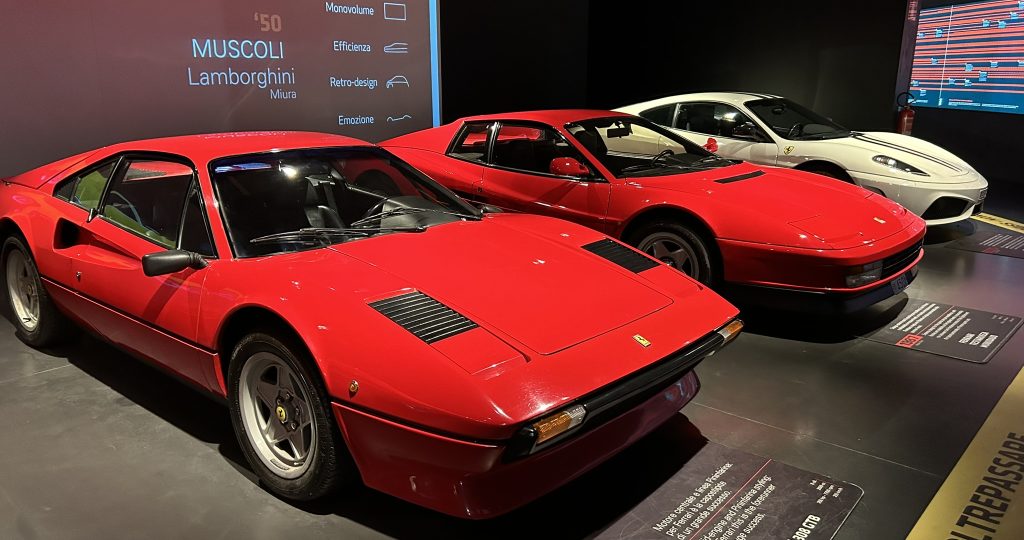
Tours in Turin
Here are some more options for tours in Turin from GetYourGuide:
Staying in Turin
We were driving both times we visited Turin. On our first short trip, we chose a hotel that was a little ways from the centro. The restful Parco Hotel Sassi fit the bill. We parked the car for free, relaxed for a while on our terrace overlooking beautiful grounds, and then took a short tram ride into Turin. Highly recommended.
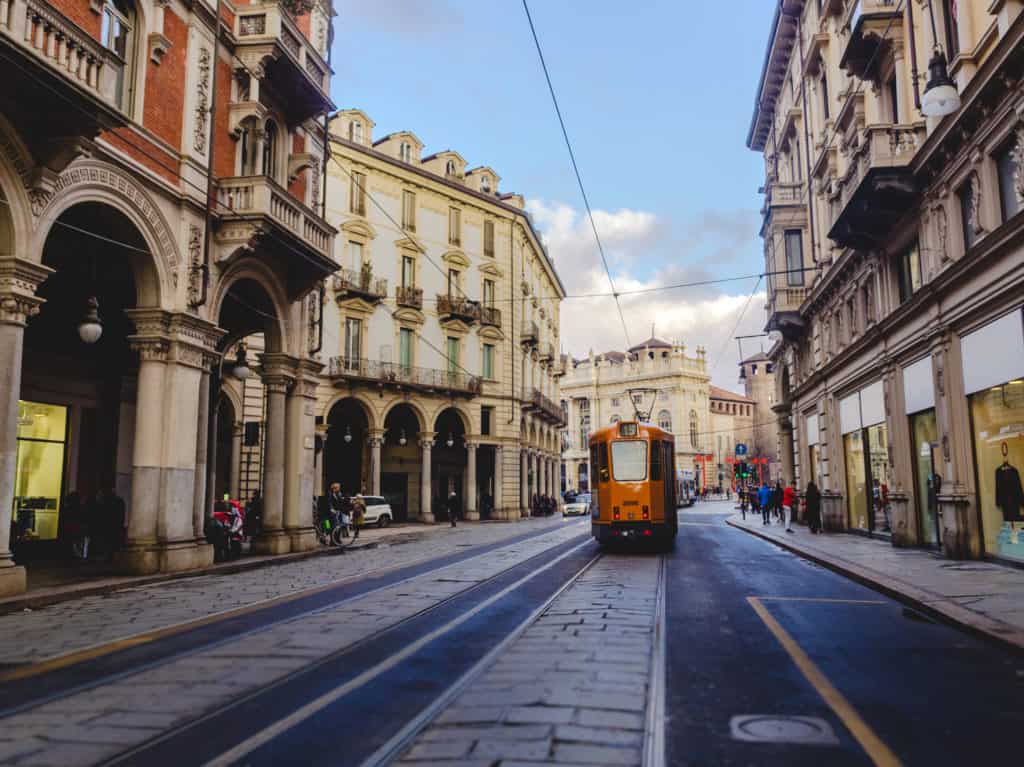
Milan
On both of my visits to Milan, I was struck by how stately and calm this Northern Italian city is, particularly compared to Rome and Naples.
I remember riding in a taxi on my first trip to Milan. We’d just taken the train from wonderful, frenetic Naples where a taxi ride was an adventure and stop signs merely suggestions, and then spent several days in Rome. In Milan, the driver swung us into lanes of slow-moving, very well-behaved traffic and steered us sedately down wide avenues. I felt like I was on a main road through a particularly safe and dull Canadian suburb.
I commented to the driver that Milan seemed very different from Rome. She harrumphed and said, “This is Milan. We are not like Roma.” I got the impression she considered that a selling point.
I’m always fascinated by regional differences within a country. Certainly the differences betwen the north and the south in Italy are particularly noticeable!
Milan is Different
The taxi driver was right. Milan is not like its more rambunctious southern neighbors. The streets are wide and the city quite spread out. Traffic is dense. However, people actually drive in the correct lanes and avoid piling into intersections and honking.
Although Rome is notorious for its pickpockets, the only time we encountered petty theft in Italy was in Milan. At our hotel near the train station, Gregg witnessed the theft of the hotel manager’s wallet from the front desk when the manager’s back was turned. The manager gave chase but to no avail.
So, the moral of that story is to never leave your valuables unattended.
On the other hand, I once left my purse containing our passports and my wallet on the counter at a very seedy hotel in Nice, only for it to still be there when, in a panic, I returned thirty minutes later.
You never know, but always err on the side of caution.
Top Sights in Milan
On a one-week itinerary touring Northern Italy, Milan is worth at least two days of your time or one very full day. I suggest you spend four days in Milan and spend one or two of them taking day tours to the Italian Lakes or spending two nights in Milan and driving to the lakes for another two nights.
If you enjoy shopping, set aside an afternoon to check out what’s on offer in Italy’s most sophisticated fashion city.
Here are the big draws in Milan.
The Duomo of Milan
The Milan Duomo is one of the largest Gothic cathedrals in Christendom, with a roof bristling with a forest of spires topped with sculptures. Make sure to buy your tickets in advance to avoid the long lines (see tour suggestions below).
Galleria Vittorio Emanuele II
After visiting the Duomo, head across the piazza to enter the Galleria Vittorio Emanuele II. Billed as an aesthetically pleasing shopping arcade, the Galleria is worth escaping into from the sun or rain to browse designer shops, such as Louis Vuitton and Prada if your budget stretches that far, or to enjoy a coffee and pastry if it doesn’t.
The 19th-century glass ceiling is magnificent.
La Scala Opera House
La Scala is located at the far end of the Galleria Vittorio Emanuele II. You’ll reach it after walking through the galleria from the Duomo. As one of the world’s most famous opera houses, it’s a must-see for music fans. Book a guided tour of the auditorium and the attached museum.
Sforza Castle
Wander through the hip Brera district, with its funky boutiques and trendy bars, to get to the imposing Sforza Castle (Castello Sforzesco).
If you’re a fan of the Medici series on Netflix (I’ve written a post about it over on Art In Fiction), you’ll remember Galeazzo Maria Sforza, one of the Sforza family’s most famous dukes. He was renowned both for his cruelty and for his patronage of music. Spoiler alert: he meets a bad end in Season 2 and in real life.
The Castello Sforzesco contains several worthwhile museums as well as Michelangelo’s unfinished Pieta. Also view the sala delle asse, a room with walls and ceiling painted by da Vinci and depicting intertwining trunks with leaves and fruit.
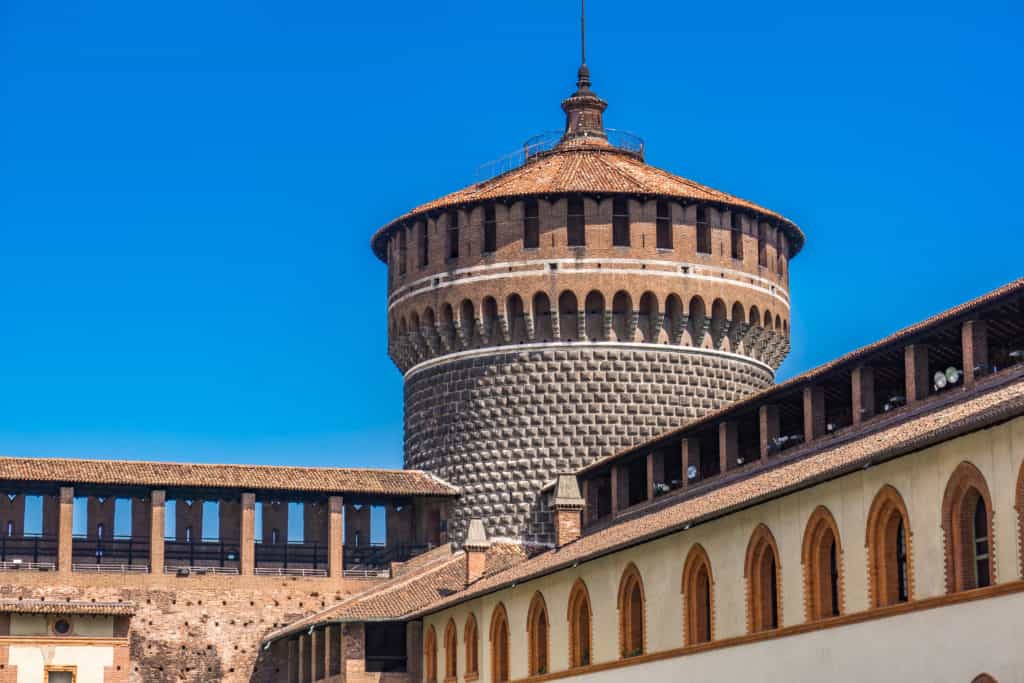
Purchase your tickets to Castello Sforzesco in advance and go early to beat the crowds (as usual!). Here’s a link to the Castello Sforzesco website.
Da Vinci’s Last Supper
Leonardo da Vinci, of Mona Lisa fame (among many other things), is also renowned as the painter of The Last Supper. Located in the refectory at the monastery of Santa Maria delle Grazie, the iconic fresco tops the list of must-see places in Milan.
But make sure to pre-book! The Last Supper is a major tourist attraction in Milan and rightly so.
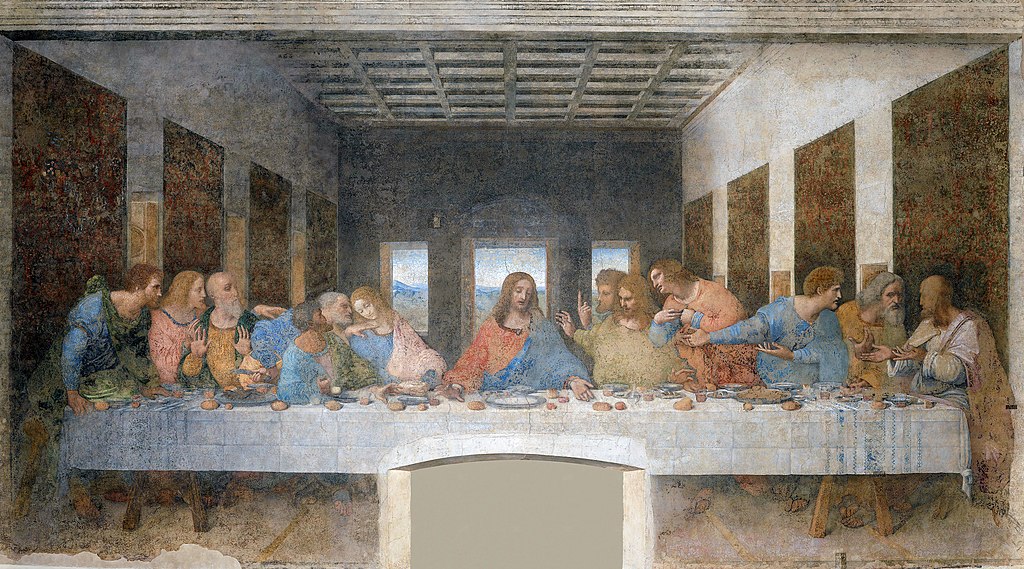
As soon as you know your travel dates in Milan, buy your tickets. Don’t wait until you get to Milan.
Once you do get inside to view da Vinci’s masterpiece, you can stay for only 15 minutes. Here is a tour options from GetYourGuide:
Sightseeing Options in Milan
Here’s a selection of artsy sightseeing options for touring Milan. Other sites include Leonardo – The World of Leonardo and the art gallery: Pinacoteca di Brera
Staying in Milan
Choose a place near the Duomo so you’re central to the main sites in Milan. Here are some options:
The Italian Lakes
This region is simply gorgeous. In fact, you’ll quickly run out of adjectives to describe the unique combo of mountain vistas and shining lake views. No wonder so many ultra-rich people have villas in the region.
My one-week itinerary of Northern Italy covers the high points of the area, but if you have more time, spend it at the lakes Maggiore, Orta, Como, Iseo, and Garda; each has its own character and charm. Your best bet for a quick visit is to take a small group tour that includes two or three of the lakes, or a boat trip.
Although a round trip of the lakes covers only about 100 miles, you’re best to find one or two spots to stay in and enjoy rather than try to see everything.
Highlights include:
- Bellagio on Lake Como from where you can take ferries and water taxies to other towns on the lake. You could spend all day cruising up and down the lake, enjoying the breezes and the stunning views, and looking out for celebrities sunning themselves on the terraces of their lakeside villas.
- Lake Garda is the largest of the lakes, with the northern half surrounded by mountains and the southern half flat. North is better!
- Sirmione on Lake Garda is known for its thermal baths and the Rocca Scaligera, a medieval castle that overlooks the lake.
- Lake Maggiore and the Barromean Islands with their ornate gardens.
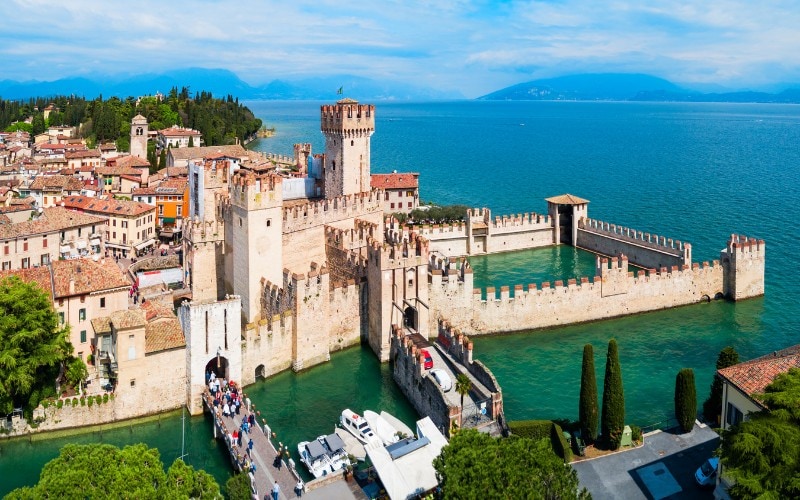
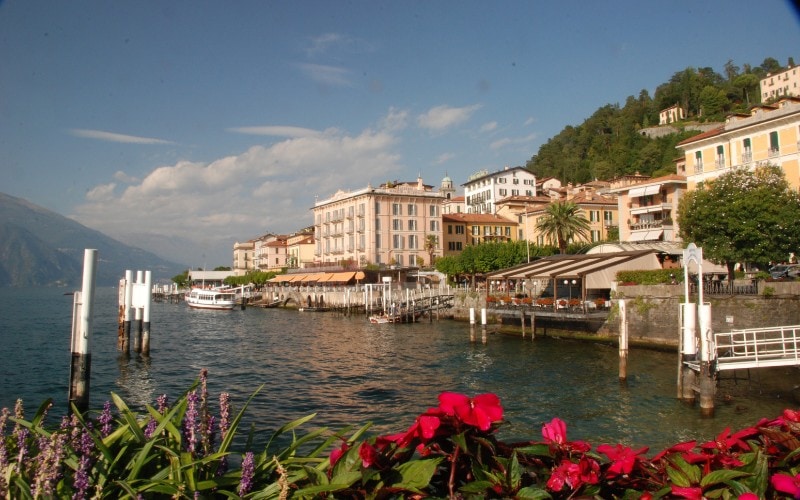
Tours of the Italian Lakes
The Dolomites
The super-jagged, needle-like peaks of the Dolomites mountain range (the Dolomiti) have long fascinated me. They don’t look real, and yet they are. We’ve driven a few times in the area, and I’d like to return to do some hiking.
Allocate at least two days to this region during a one-week tour around Northern Italy.
Bolzano
Bolzano is a pleasant town considered the gateway to the Dolomites. We were impressed by the distinctive architecture of many of the buildings, some painted in pastel colors.
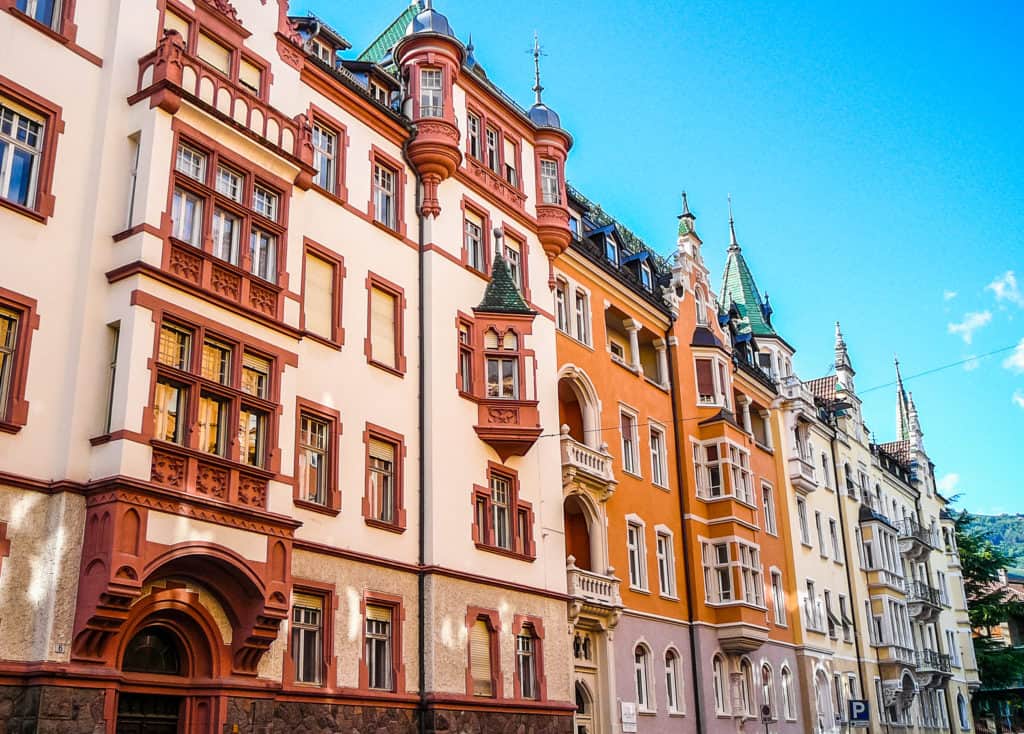
A big draw in Bolzano is the South Tyrol Museum of Archaeology. Visit “Ötzi”, a well-preserved mummy of a man from about 3300 BC and the world’s oldest natural human mummy.
For more information, check the museum website.
Alpine Options
If you’re driving, head a little farther into the mountains and base yourself in Castelrotto. From there, go hiking in the Alpe di Siusi, a large Alpine meadow. Cable cars whisk you from stations near your hotel up to the meadow.
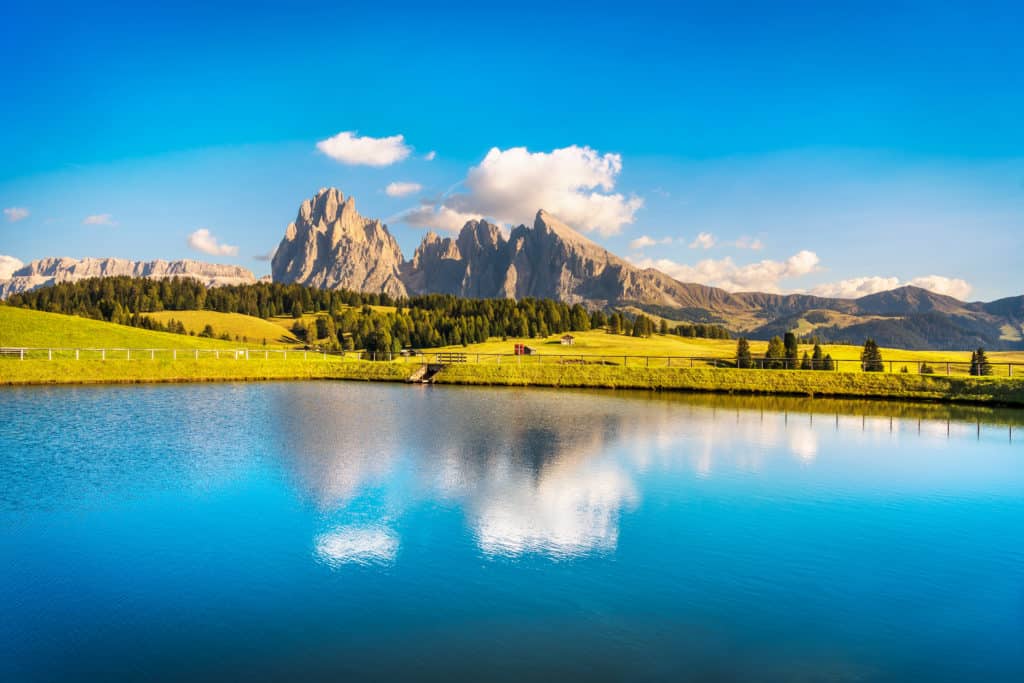
Another gorgeous location in both winter and summer is Alta Badia. Check the town’s excellent website for more information.
Staying in the Dolomites
The map below provides some options for staying in the Dolomites.
Carrying on South Into More Italy
If you’re driving into Italy through Bolzano, your next stop will probably be Venice.
If you’re driving into Italy through Turin, you’ll likely head south into Tuscany and Umbria, perhaps stopping on the way to check out the Cinque Terre.
You can also catch the high-speed train from Milan south to Florence and Rome.
Conclusion
Have you toured Northern Italy? What did you think? Do you have suggestions for must-sees (especially artsy-oriented must-sees) to share with other travelers? Add them to the comments below.
Here are more posts to help you plan your Italian travels:
- Itinerary for a Perfect Week in Italy’s Campania
- Ten Must-See Art Masterpieces in Tuscany
- Exploring Tuscany, Umbria and La Dolce Vita
- Best of Rome in Three Days
- Compelling Novels Set in Italy Perfect for the Artsy Traveler
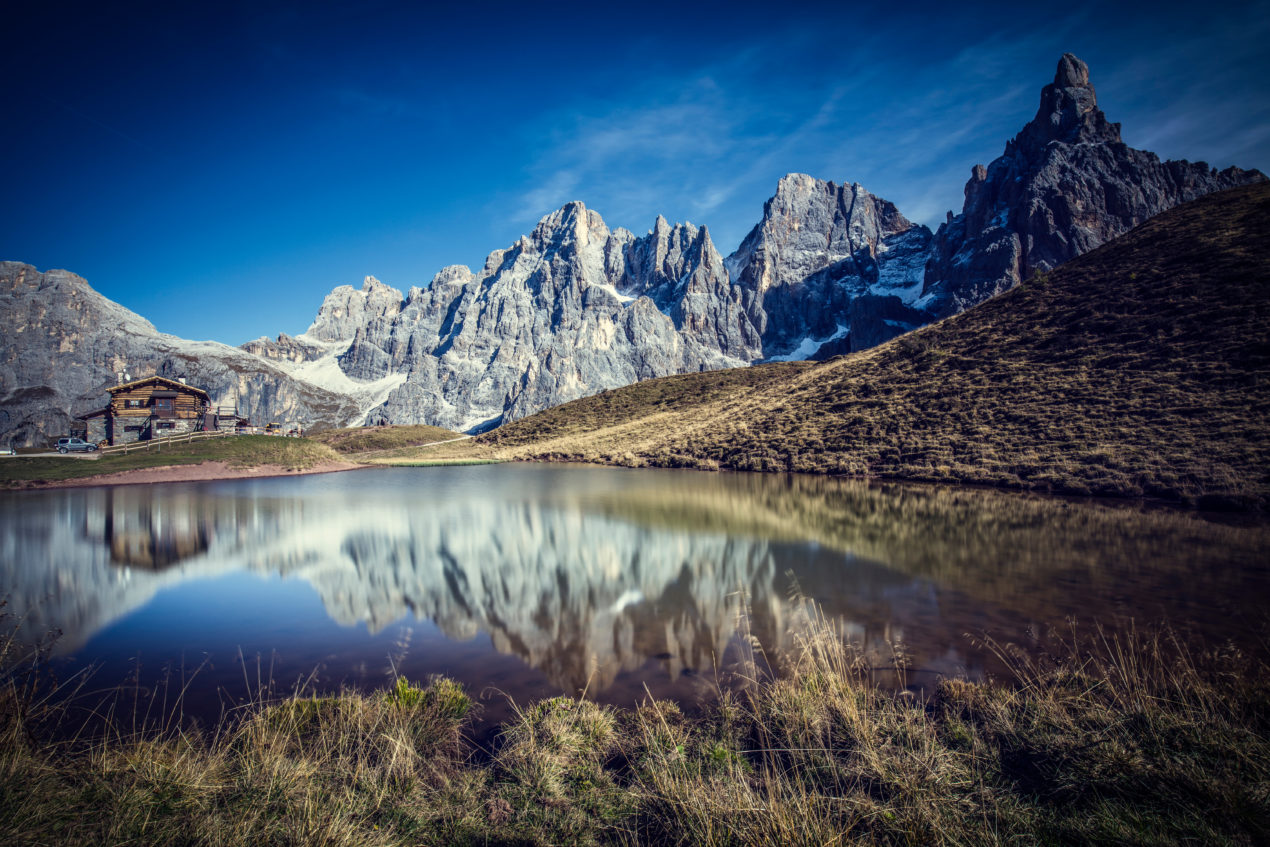
[…] Read Recommended Places to Travel in Northern Italy […]